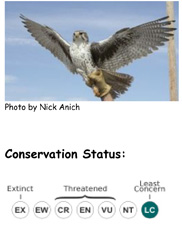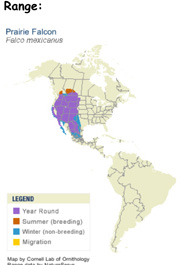Learn About Prairie Falcon
The Prairie Falcon (Falco mexicanus) is a medium-sized falcon of western North America. Plumage is warm gray-brown (sometimes called “sandy”) above and pale with more or less dark mottling below.
It is about the size of a Peregrine Falcon, with an average length of 40 cm (16 in), wingspan of 1 metre (40 in), and weight of 720 g (1.6 lb). As in all falcons, females are noticeably bigger than males.
It breeds from southern Manitoba, Saskatchewan, Alberta and south-central British Columbia south through the western United States.
The habitat is open country, especially arid, in summer including alpine tundra to shortgrass prairie and high desert. In winter it is more widespread, ranging to low deserts and occasionally to towns.
The Prairie Falcon eats mostly small mammals (especially in summer) and birds caught in flight.
This species nests on cliff ledges. The clutch averages four eggs, which are pinkish with brown, reddish-brown, and purplish dots. The incubation period is 31 days. The young fledge from 36 to 41 days after hatching and remain with the family for a short time before dispersing.

Scientific Classification:
- Kingdom: Animalia
- Phylum: Chordata
- Class: Aves
- Order: Falconiformes
- Family: Falconidae
- Genus: Falco
- Species: F. mexicanus

References: * BirdLife International (2004). Falco mexicanus. 2006 IUCN Red List of Threatened Species. IUCN 2006. Retrieved on 12 May 2006. Database entry includes justification for why this species is of least concern * Sibley, David Allen (2000): The Sibley Guide to Birds. Alfred A. Knopf, New York. * Dunne, Pete, Sibley, David Allen & Sutton, Clay (1989): Hawks in Flight. Houghton Mifflin. * Griffiths, Carole S. (1999): Phylogeny of the Falconidae inferred from molecular and morphological data. Auk 116(1): 116–130. * Helbig, A.J.; Seibold, I.; Bednarek, W.; Brüning, H.; Gaucher, P.; Ristow, D.; Scharlau, W.; Schmidl, D. & Wink, Michael (1994): Phylogenetic relationships among falcon species (genus Falco) according to DNA sequence variation of the cytochrome b gene. In: Meyburg, B.-U. & Chancellor, R.D. (eds.): Raptor conservation today: 593-599. * Howell, Steven N. G. & Webb, Sophie (1995): A Guide to the Birds of Mexico and Northern Central America. Oxford University Press, Oxford & New York. * Nittinger, F.; Haring, E.; Pinsker, W.; Wink, Michael & Gamauf, A. (2005): Out of Africa? Phylogenetic relationships between Falco biarmicus and other hier ofalcons (Aves Falconidae). Journal of Zoological Systematics and Evolutionary Research 43(4): 321-331. * Wink, Michael & Sauer-Gürth, Hedi (2000): Advances in the molecular systematics of African raptors. In: Chancellor, R.D. & Meyburg, B.-U. (eds): Raptors at Risk: 135-147. WWGBP/Hancock House, Berlin/Blaine. * Wink, Michael; Seibold, I.; Lotfikhah, F. & Bednarek, W. (1998): Molecular systematics of holarctic raptors (Order Falconiformes). In: Chancellor, R.D., Meyburg, B.-U. & Ferrero, J.J. (eds.): Holarctic Birds of Prey: 29-48. Adenex & WWGBP. * Wink, Michael; Sauer-Gürth, Hedi; Ellis, David & Kenward, Robert (2004): Phylogenetic relationships in the Hierofalco complex (Saker-, Gyr-, Lanner-, Laggar Falcon). In: Chancellor, R.D. & Meyburg, B.-U. (eds.): Raptors Worldwide: 499-504. WWGBP, Berlin.

